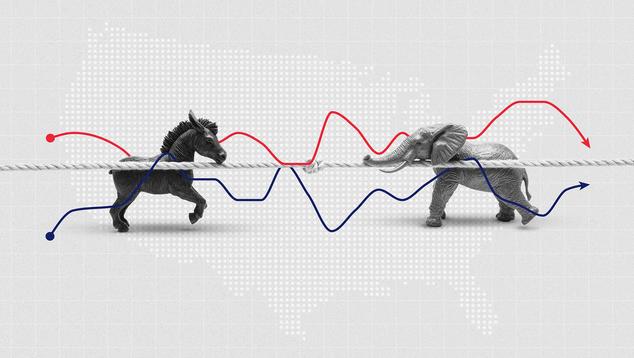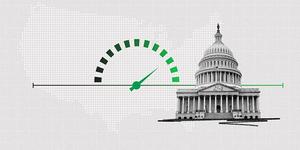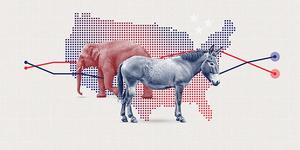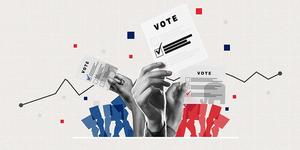Story Highlights
- Republicans’ lead as party trusted more to keep country safe has shrunk
- Parties now tied in views of which is better for keeping country prosperous
- Americans tend to like GOP on issues, Democrats on political values
WASHINGTON, D.C. — Americans continue to see the Republican Party as better than the Democratic Party for protecting the U.S. from international threats, 48% to 41%, though the margin has narrowed since last year. However, the same survey, which began before the government shutdown and the Israel-Hamas ceasefire deal, also finds the GOP has lost its advantage as the party better for keeping the country prosperous.
In both cases, Republicans’ weaker position is mainly the result of fewer Americans than a year ago preferring the Republican Party for these responsibilities, not because of increased confidence in the Democratic Party to handle them.
The latest results are from Gallup’s annual Governance poll, conducted Sept. 2-16.
In the same poll, the parties are closely matched in overall favorability, with both seeing some slippage in their ratings since last fall. Republicans are now viewed favorably by 40% of U.S. adults, compared with 43% in September 2024. Democrats’ current 37% favorable rating is down from 42%.
Republicans’ Biden-Era Bump Has Faded
Americans’ perceptions of the two major parties today represent a change from the prior four years, during Joe Biden’s presidency, when they expressed strong preferences for Republicans over Democrats for protecting the country and keeping it prosperous.
In contrast to their current four-percentage-point deficit on maintaining prosperity, Republicans had no less than a six-point advantage during Biden’s term, stretching to 14 points in 2023, when Americans favored Republicans over Democrats by 53% to 39%. The last time Republicans had that sizable an advantage on this key measure was in 1991, during a pro-Republican rally in public attitudes after the Gulf War.
Republicans’ current seven-point lead in public perceptions as the party better able to protect the U.S. from terrorism and military threats is down from 22 points in 2023. Republicans have led on this measure nearly every year since the start of the trend in 2002, with the lead averaging 10 points and peaking at 23 points in 2014.
Parties Maintain Low Favorable Ratings
The current three-point gap in Republicans’ and Democrats’ party favorable ratings, 40% and 37% respectively, is similar to the four-point advantage Republicans enjoyed in July.
By contrast with the other party indicators reviewed here, which showed strong Republican advantages in 2023 or 2024, Republicans’ favorable rating exceeded the Democrats’ by no more than six points during Biden’s presidency, with that reading coming in 2024 right after the election that returned Trump to office. Longer term, any Republican lead in favorability has been fairly rare in this trend since 1992.
Underscoring the parties’ image problems, at least half of Americans have viewed both parties unfavorably in every Gallup reading since August 2020, except in early 2021 (for Democrats) and November 2024 (for Republicans), when that party’s unfavorable rating dipped to 48%. Currently, 58% view the Republican Party unfavorably and 61% the Democratic Party.
Key Indicator Turns From Red Back to Blue
Each September since 2004, Gallup has followed its open-ended “Most Important Problem” facing the country measure with a question asking respondents which party they think can better handle whatever issue they just mentioned. The Democrats’ two-point numerical lead on this today contrasts with three- to 11-point Republican leads during Biden’s presidency.
This measure has proven to be a key indicator in presidential election years, with the party preferred for the top problem winning in most elections going back to 1952.
What Americans Like About Each Party
To further understand Americans’ perceptions of the parties, an August Gallup Panel web survey asked respondents to say in their own words what they like and dislike about each party. The responses make clear that the parties are perceived differently by Americans, despite their similar favorable ratings.
On the positive side, the GOP is most often lauded for its policy positions, with 30% of Americans citing any sort of issue or policy. This is followed by its perceived values (24%) and then its political skill or competence (10%), with relatively few citing its leaders (3%). By contrast, the Democratic Party is chiefly commended for its perceived values (44%) followed by issue positions (20%), with few citing either its political skill (3%) or leaders (3%). About a quarter of Americans for each party say they like nothing about it, while just over 10% have no opinion.
The following table shows the top specific responses that fall within each category of reasons Americans give for liking each party.
The most striking result is the 20% of Americans who, in reference to the Democratic Party, say it cares about the middle or working class (falling under the values category). This is the largest response given as a positive or negative impression of either party. The 9% citing Democrats’ support for diversity and inclusivity is also among the larger individual responses given to the party perception questions.
Immigration is the chief issue people praise Republicans for, at 8%, followed by fiscal policy (7%). Meanwhile, abortion/pro-choice policies (4%), healthcare reform (3%), environmental policies (3%) and LGBTQ+/civil rights (3%) are the top issue-based mentions for Democrats.
Several responses related to party cohesion are given as reasons for liking the Republican Party, while few offer these reasons for Democrats. As far as naming party leaders, President Donald Trump is cited by 2% of Americans as a reason they like the Republican Party, with another 1% mentioning Republican candidates generally.
As would be expected, partisans have sharply different reasons for liking or disliking each party. About equal proportions of Republicans cite issues (49%) and values (55%) as reasons for liking their own party, while more independents and Democrats mention issues than values. By contrast, the reasons Democrats give for liking their party are dominated by mentions of the values it represents (such as defending the middle class) rather than for its issue positions (72% vs. 30%, respectively). The same pattern is seen with what independents find appealing about Democrats (43% values vs. 19% issues), while similar percentages of Republicans mention values and issues (18% and 12%).
What Americans Dislike About Each Party
Americans’ responses to what they dislike about the Republican and Democratic parties are similar, in terms of the broad groupings. Values are most likely to be cited for both — 43% for the Republicans and 42% for the Democrats. This is followed by issues, at 31% for the Republicans and 26% for the Democrats.
Beyond those similarities, people are more likely to knock the Republicans (19%) than Democrats (9%) for their leaders, while they are more likely to criticize Democrats (24%) than Republicans (7%) for lack of political skill.
The following table shows the top specific responses that fall within each category of reasons Americans give for disliking each party.
Within the values category, Democrats are commonly faulted for a lack of morals, being cowardly and not standing up for the common person, as well as for being too liberal. The top negative mentions of Republicans’ values are being dishonest, protecting the rich and disregarding the Constitution and law.
The issues mentioned most often as a reason for not liking Republicans are opposition to LGBTQ+ rights or racial equality (7%), having bad policies in general (6%), immigration (5%) and spending too much (5%). The top issue-related dislike of Democrats is a general one — having poor policies (8%). But immigration is next at 6%, followed by 3% each mentioning abortion/women’s rights, transgender issues and raising taxes.
Under the leaders category, Trump is the primary subject of responses people give for disliking the Republican Party. Nine percent name Trump himself, while 7% cite the party’s support for Trump. The largest specific response related to leaders given as a reason for disliking Democrats is having poor leadership generally (8%).
Americans cite several aspects of Democrats’ lack of political strength as reasons they dislike the party. Being too weak (7%) and not fighting against Trump (6%) are the primary ones, but 3% each also cite bad messaging, lack of unity and being disorganized or without a plan. The much smaller percentage of Americans citing any kind of lack of political acumen as something they dislike about the GOP centers on it not standing up for its positions (6%).
Republicans are about equally likely to mention issues (25%) and values (29%) as things they dislike about the Republican Party, while larger proportions of Democrats (58%) and independents (43%) cite values. Values is the most common criticism Republicans have of Democrats (named by 61%), while about four in 10 Democrats cite frustration with their own party’s political acumen or competence (41%), followed by values (34%). The plurality of independents cite one or more values (38%) as what they dislike about Democrats, followed by issues (26%) and competence (21%).
Bottom Line
When Americans are pressed to choose which party is better equipped to handle the nation’s key issues of prosperity and security, Gallup finds the tide has shifted away from the GOP after helping fuel Trump’s reelection. Yet, while Republicans have lost ground this year on the key issues of maintaining prosperity and national security, Democrats have seen no corresponding gains. Relatedly, Americans remain broadly dissatisfied with both major parties, with neither viewed favorably by even half of the public.
While voters may be disillusioned with the parties overall, and favor the emergence of a third party, they still see meaningful differences in what each party stands for, evidenced both in their shifting preferences for the parties on issues, and in what they say they like and dislike about each party. The lists could provide each party with insights into connecting with voters in the 2026 midterm elections and beyond.
Both parties face significant challenges in addressing negative public perceptions, largely around the values that they or their policies represent. But focusing on the positive, with Republicans setting the agenda in Washington, their perceived strengths lie more with policy positions, largely aligning with Trump’s priorities since taking office. As the opposition party, the Democrats are noted for political ideals long associated with the Democratic Party, such as being the party of the working class or championing equality and diversity.
Stay up to date with the latest insights by following @Gallup on X and on Instagram.
Learn more about how the Gallup Poll Social Series works.




